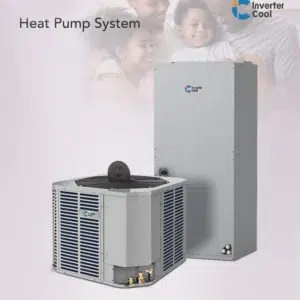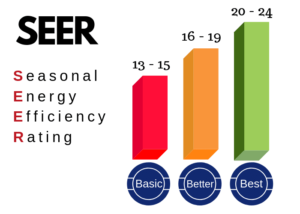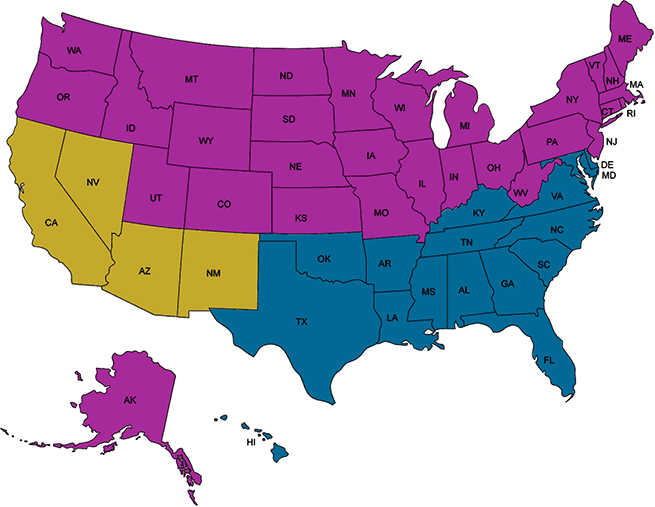SEER Calculator
How much money can you save when you upgrade to a higher efficiency air conditioner?

Energy efficiency in every air conditioner or heat pump is measured by a SEER (Seasonal Energy Efficiency Ratio) rating. The higher the rating, the less electricity the unit will use.
The SEER Savings calculator can answer some of the most common questions, including:
- How much can I actually save if I upgrade to an air conditioner with higher efficiency?
- When looking at 14 SEER and 25 SEER air conditioners, what is the difference in energy cost?
- What are the energy costs with my current air conditioner?
Use the SEER Savings Calculator to find out instantly!
How Does the Calculator Work?
Wondering how it works? Let’s find out. The idea behind it’s main purpose is to help compare cooling costs between two different air conditioners with different SEER ratings. You are then able to map this out over 1, 5, 10, and 15 year periods.
There are four factors it uses to figure out how much it is costing you to cool your home per year:
- Current air conditioner’s SEER rating
- The size of your air conditioner (in tons)
- The current energy costs in your area per kilowatt-hour (Kwh)
- The estimated annual cooling hours for your home based on your location (from the EPA, 2002)

It takes all of this information and compares it to an air conditioning unit with a higher efficiency rating and calculates how much you can save annually. You can easily see your potential savings over 1, 5, 10, and 15 year periods.
What is SEER?

Seasonal Energy Efficiency Ratio. It is the system that measures the efficiency of air conditioners and heat pumps. The higher the rating, the less electricity the unit will consume. It is an official term defined by the AHRI (Air conditioning, Heat and Refrigeration Institute) standard 210/240
How is SEER Rating Calculated?
According to the AHRI, the first thing to determine is the total amount of heat removed from a home during any typical season. This is measured in BTU (British Thermal Units). Next, the BTU’s are divided by the total electrical energy the unit consumes during the same time period. This is expressed as watt-hours (Wh). SEER = BTU / Wh.
Another factor in the equation is the indoor and outdoor temperature. As we all know, the outside temperature never stays the same from day to day or week to week due to weather and climate. The equation for calculating SEER takes this into account by using a set range of possible outdoor temperatures (65F – 104F). Then, these temperatures are split into 8 sets (aka “bins”) of 5 degree increments. The average temperature of each bin is assigned a percentage of the annual cooling hours. Indoor temperatures are much less complicated, and are set as 80F with 50% relative humidity. It is important to note that those numbers are applied to the return air, not the supply air.
As with most numbers and degree of measurements, this differs in Europe, where they use ESEER (European Seasonal Energy Efficiency Ratio).
HSPF and EER
You will undoubtedly come across a couple of other lesser known acronyms referring to the energy efficiency of air conditioners – HSPF and EER. Although they are not used in this calculator, it is still useful to know what they are.
Heat pumps are also rated by the HSPF rating (in addition to SEER). Due to the ability of a heat pump to operate in both directions (which means it can pump warm air from the inside to the outside for cooling as well as pumping warm air from outside to the inside to heat your home), it is given an HSPF rating which stands for Heating Seasonal Performance Factor
HSPF is similar to SEER in the fact that the calculations are similar (dividing the total BTU required to heat a home during a typical season by the total amount of energy the heat pump consumes in watt-hours).
EER, or Energy Efficiency Ratio, is again similar to SEER and is calculated in almost the exact same way (BTU / Wh). The one main difference is that EER does not factor in variations in outdoor temperatures during the season – it uses a set temperature: 95F. SEER and EER use the same indoor return air temperature.
Current Air Efficiency Standards
There are a set of national energy efficiency standards that enforce a minimum SEER rating on every single air conditioner or heat pump unit sold and installed.

2023 SEER and SEER2 Mins
| North Region | Heat Pump | AC | Packaged Unit |
| Min. SEER Rating | 15 | 14 | 14 |
| Min. HSPF Rating | 8.8 | 8 | |
| Min. SEER2 Rating | 14.3 | 13.4 | 13.4 |
| Min. HSPF2 Rating | 7.5 | 6.7 | |
| South Region | Heat Pump | AC | Packaged Unit |
| Min. SEER Rating | 15 | 15 | 14 |
| Min. HSPF Rating | 8.8 | 8 | |
| Min. SEER2 Rating | 14.3 | 14.3 | 13.4 |
| Min. HSPF2 Rating | 7.5 | 6.7 | |
| Southwest Region | Heat Pump | AC | Packaged Unit |
| Min. SEER Rating | 15 | 15 | 14 |
| Min. HSPF Rating | 8.8 | 8 | |
| Min. EER Rating | 12.2 | ||
| Min. SEER2 Rating | 14.3 | 14.3 | 13.4 |
| Min. HSPF2 Rating | 7.5 | 6.7 | |
| Min. EER2 Rating | 11.7 |
It is recommended that those who still own air conditioners from the 1990’s that have SEER ratings as low as 6 upgrade their systems as soon as possible.
How do I find my SEER rating?
This is quite easy. There are a number of ways to quickly find this out:
- You can go outside and look at your condenser unit. There should be a large, yellow sticker titled “EnergyGuide” that clearly displays the SEER rating.
- If there is no yellow sticker (or it is damaged/destroyed), you can look at the air handler. This is the unit that is located inside your home (garage, attic, etc). There may be a sticker on that unit containing the SEER rating and other information.
- If for any reason both options do not work for you, there is another option. You will need to find out the unit’s manufacturer, model number, and serial number. This information should be attached or written somewhere on it. Once you find it, go to the manufacturer’s website and do one of the following:
- Call their customer service and give them the information as they should be able to quickly find out the SEER rating and any other information you may need
- Find a local, certified dealer of your unit’s manufacturer’s products and give them a call. Most manufacturer websites will have a dealer locator on them.
Mismatched Systems
In order to achieve maximum efficiency, the condenser and air handler must match. This means that the air handler must be compatible to work with the condenser as intended by the manufacturer. Although it is typically required for HVAC contractors to install matched pairs, it may not always happen.
AC Tonnage
This refers to the AC unit’s size, as in cooling capacity. It has nothing to do with the physical weight of the unit. It tells us how much heat the unit is able to remove from your home in the span of 1 hour. A general rule of thumb is that an air conditioning unit will remove 12,000 BTU’s of heat per ton every hour.
Want to know what size unit you’ll need to effectively cool your home? There are a few factors to take into account, such as: square footage, the number of occupants, and the number of windows. Here are some general numbers regarding typical sizes of AC units based on the square footage of the living space. If your home is very large, you will likely need multiple units running in tandem to cool your home. It is important to know that any unit larger than 5 tons is considered a commercial unit and is not available for residential use.
Typical Tonnage by SQFT
| SQFT | Size (in Tons) |
| 750 to 1,000 | 1.5 – 2 |
| 1,050 to 1,400 | 2.5 |
| 1,450 to 1,700 | 3 |
| 1,750 to 1,900 | 3.5 |
| 1,950 to 2,200 | 4 |
| 2,250+ | 5 |
